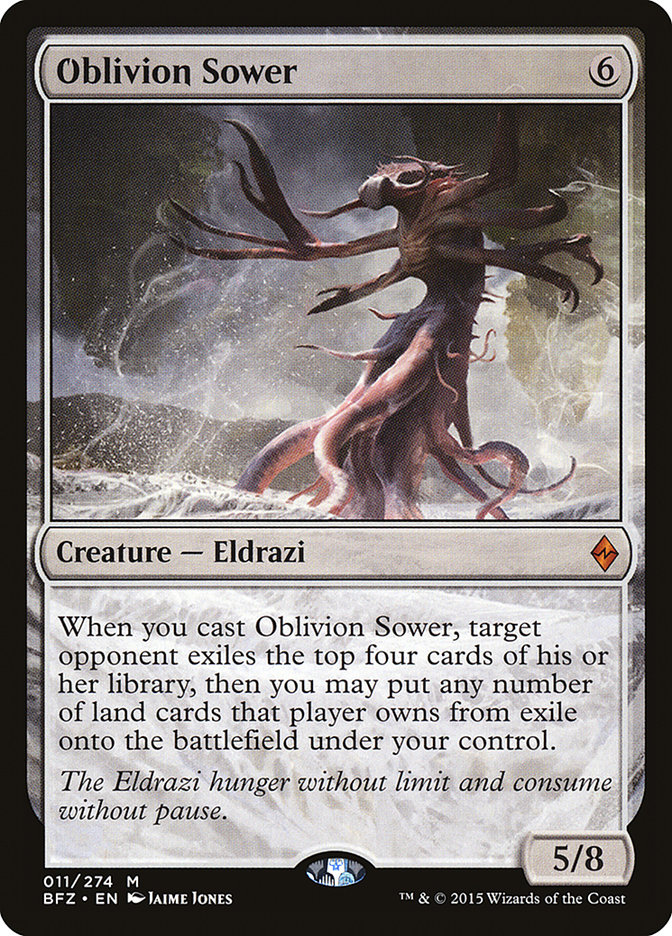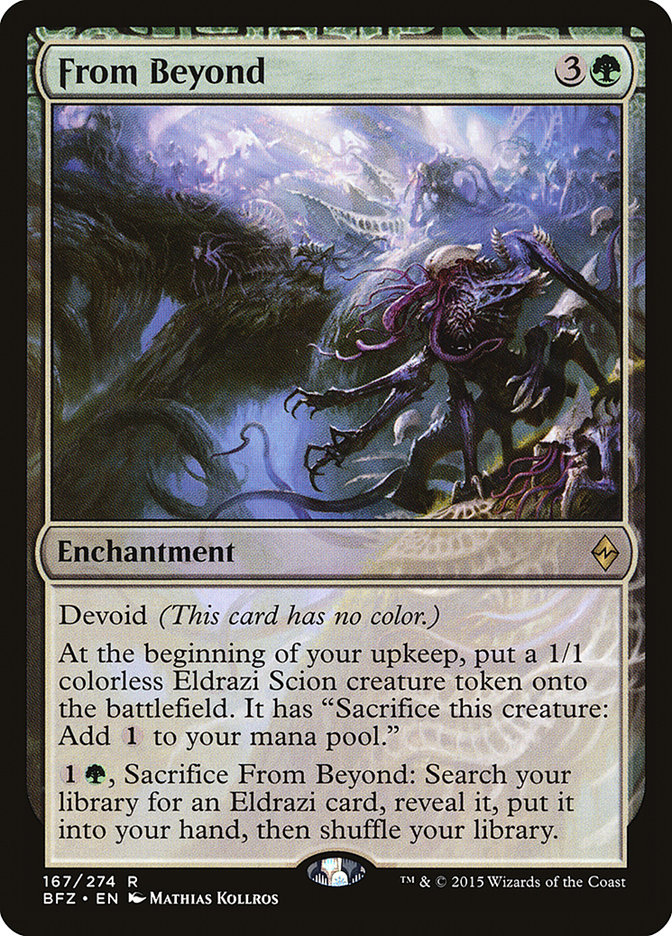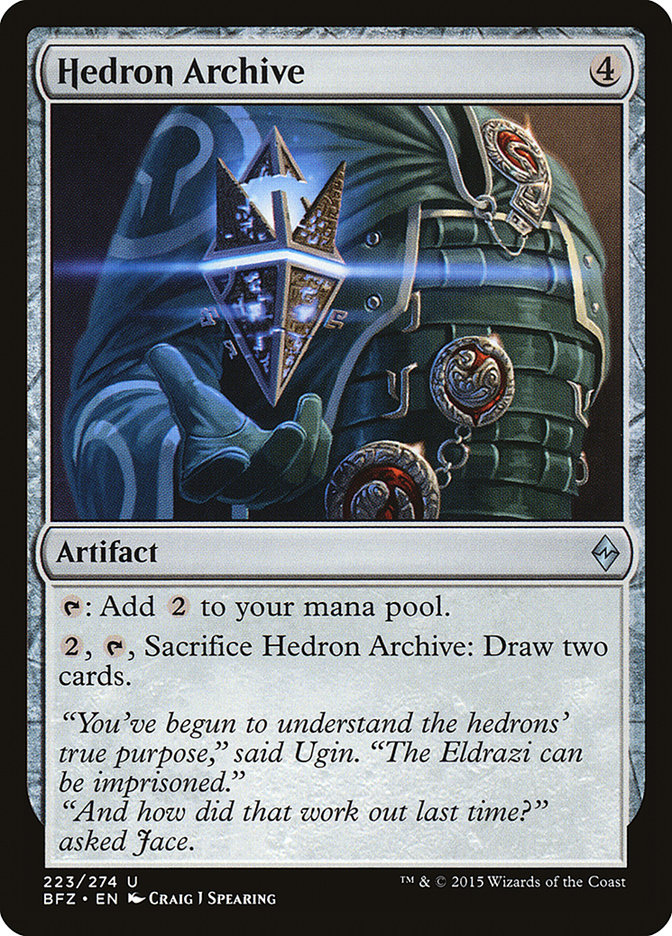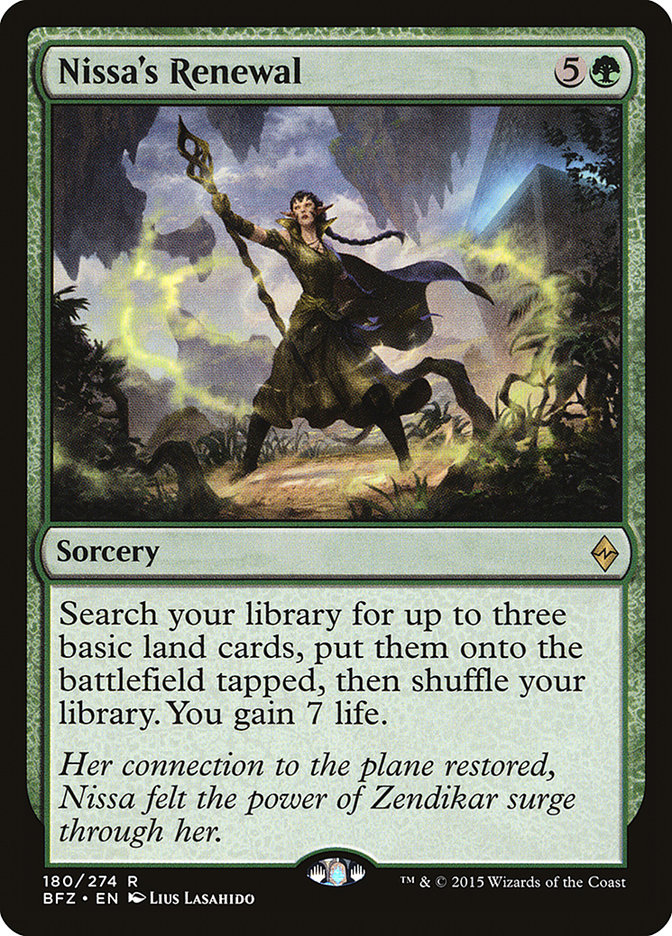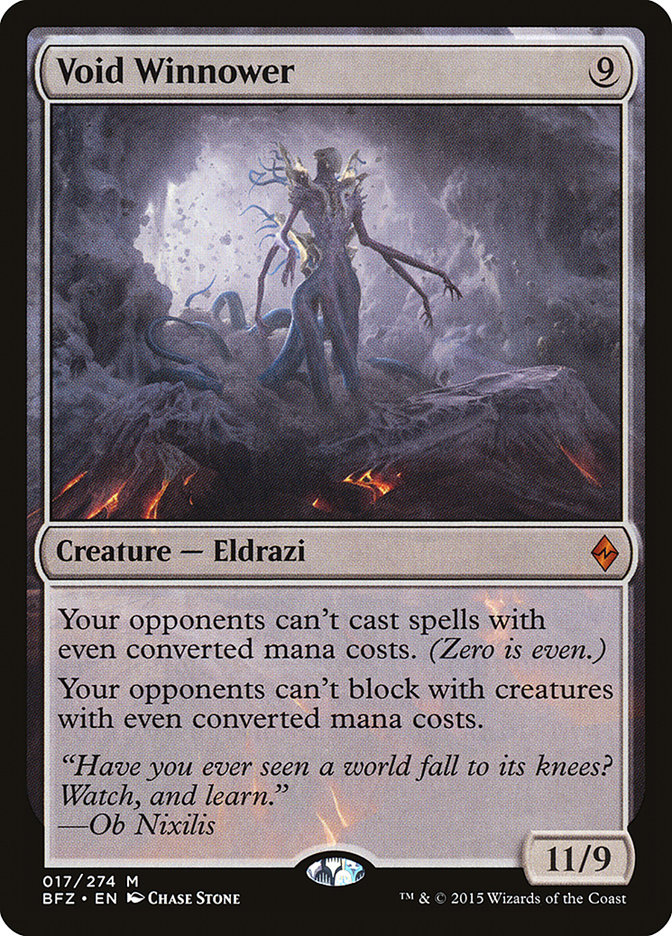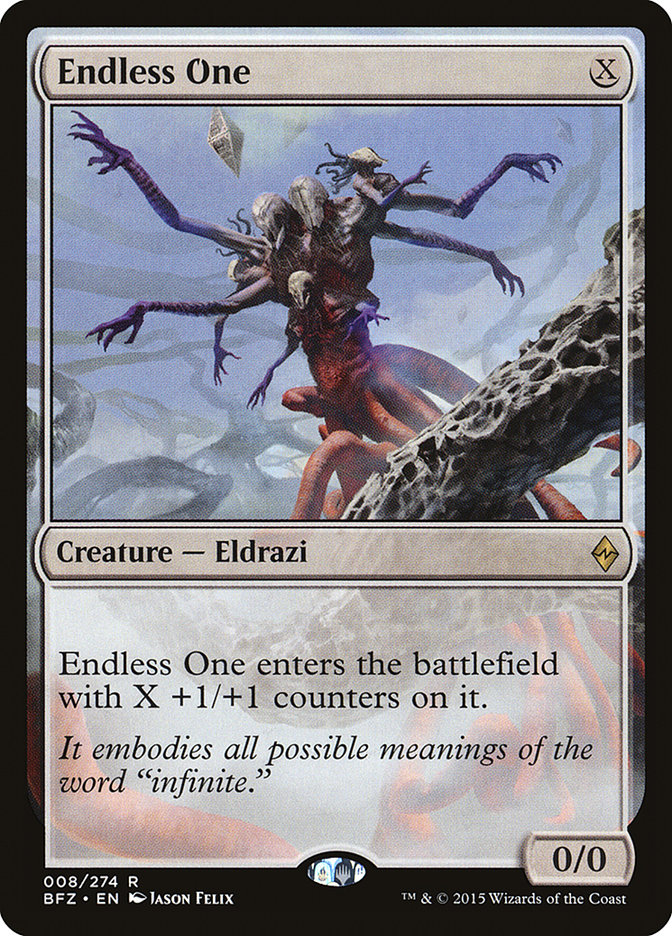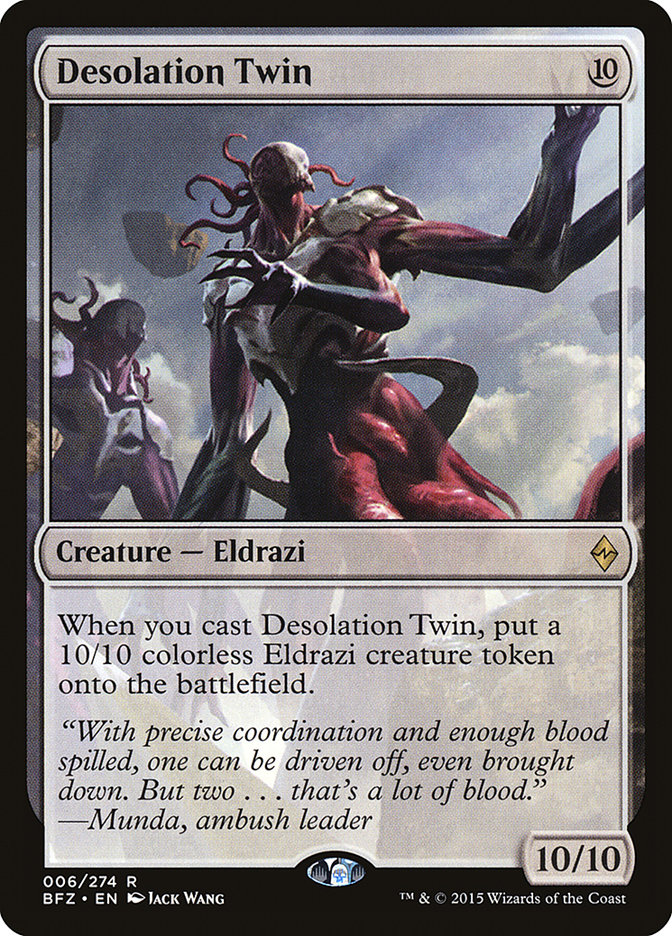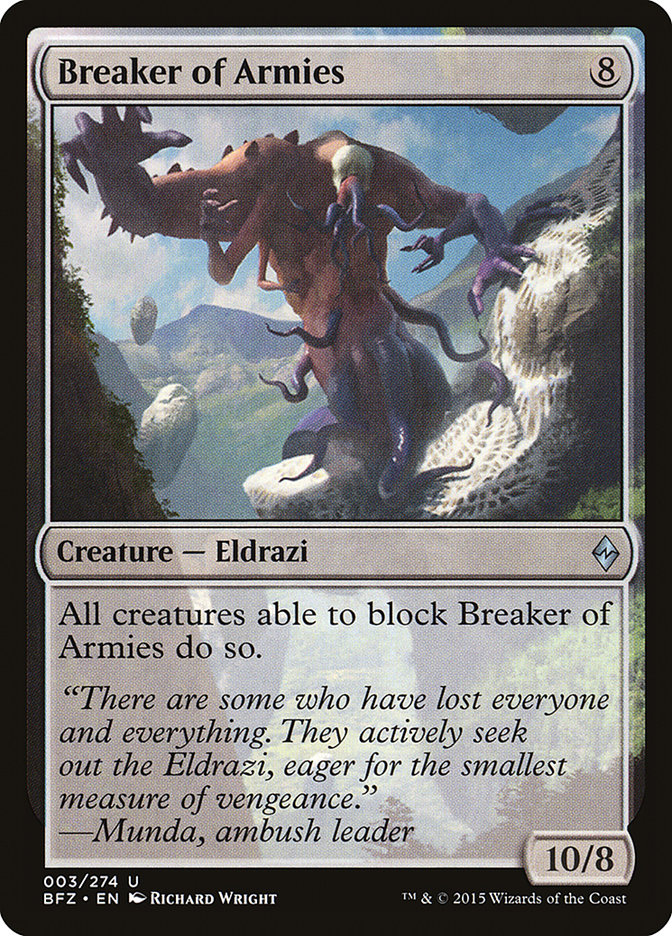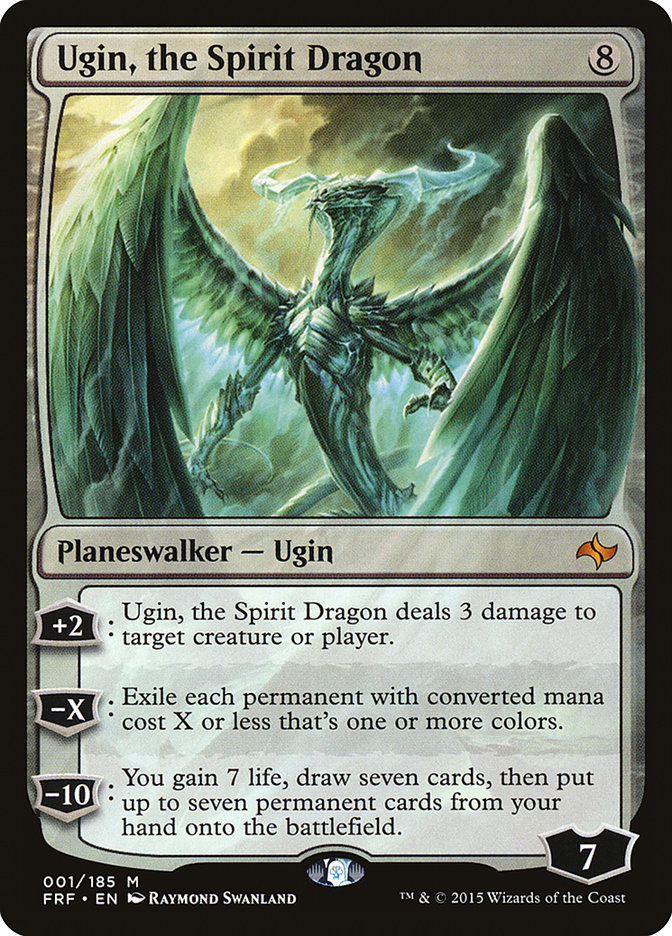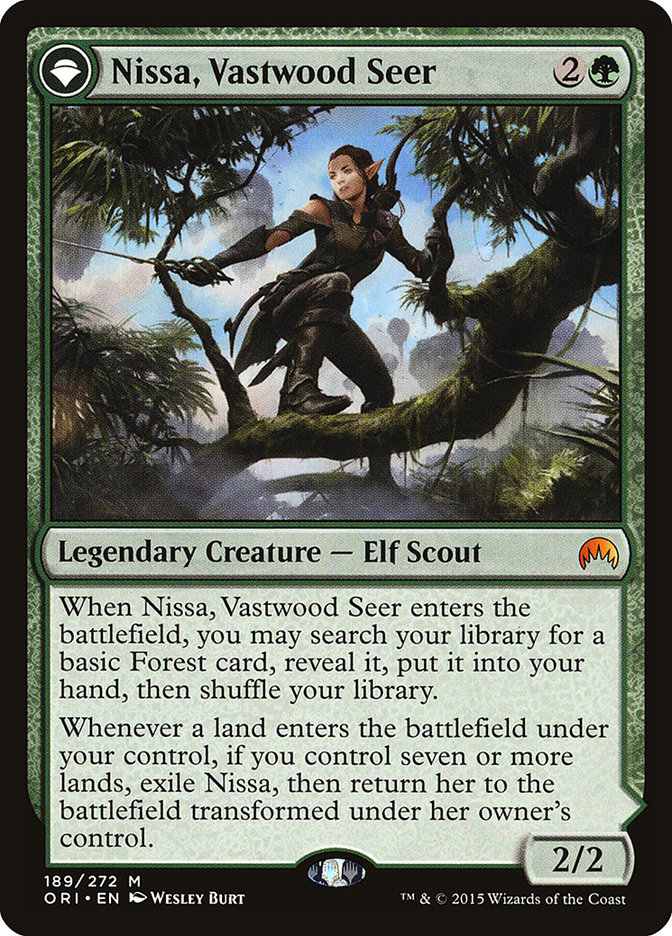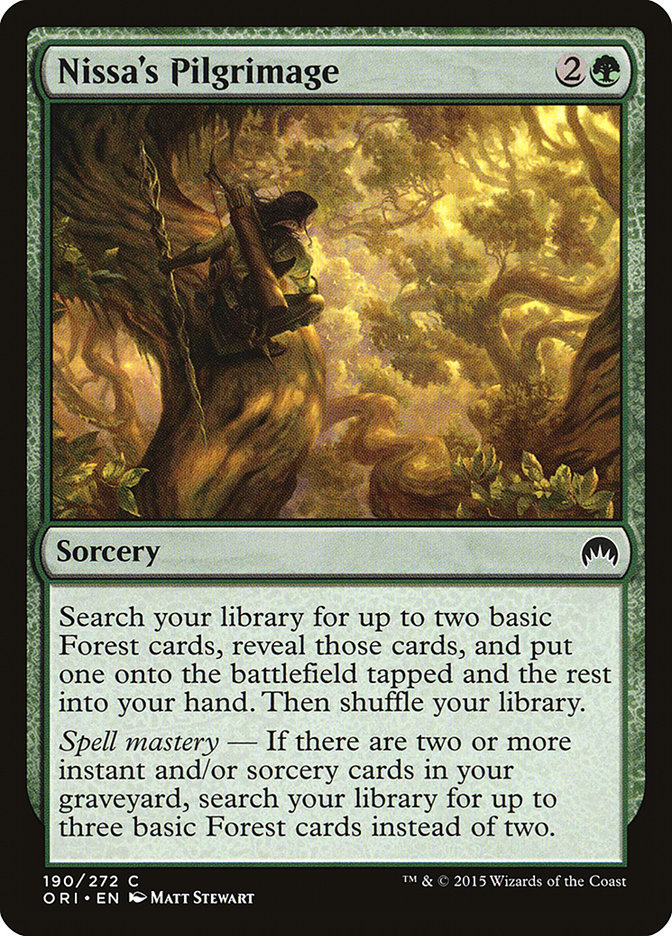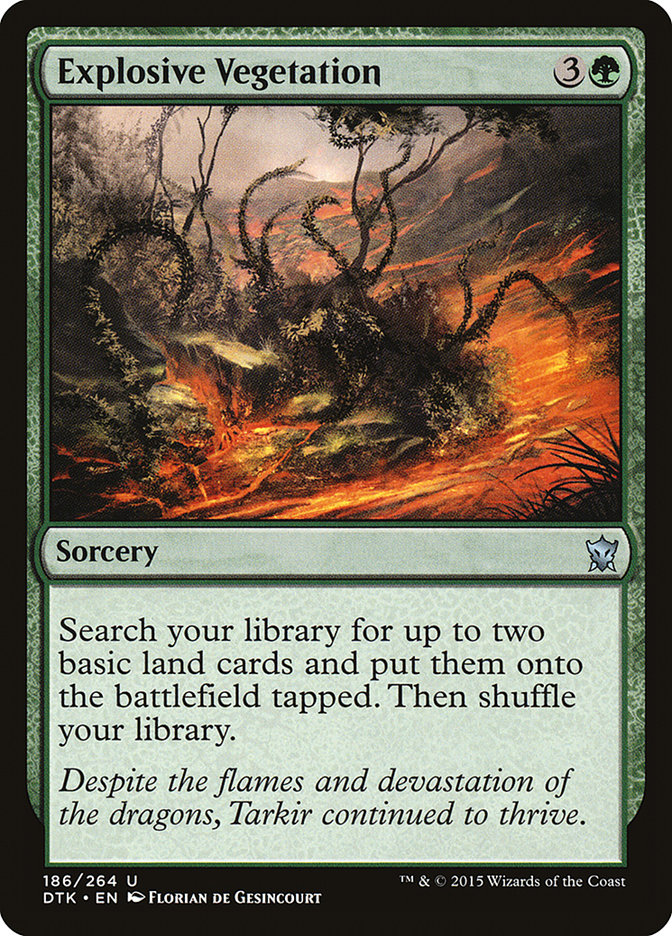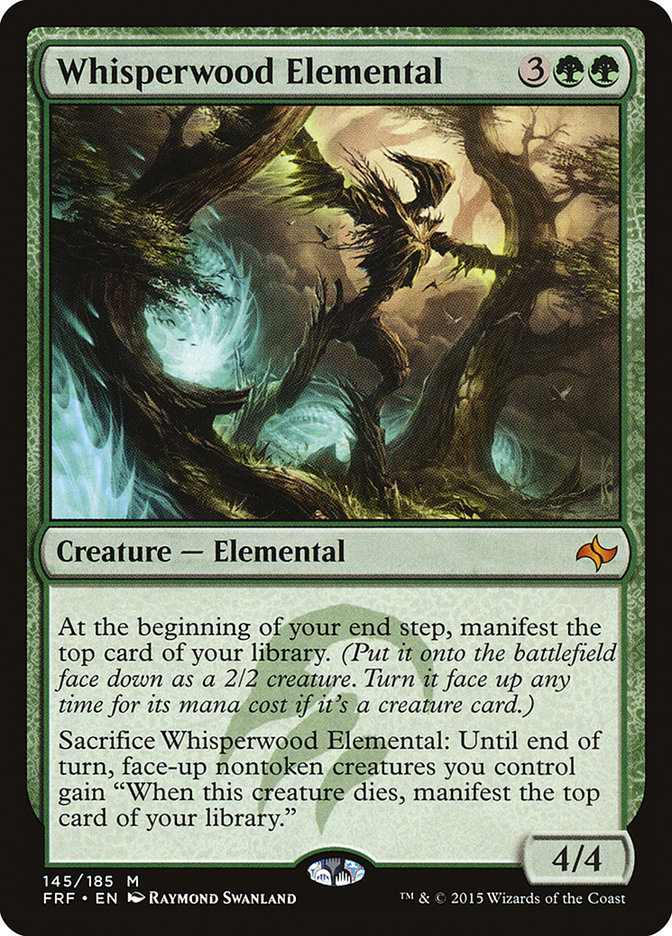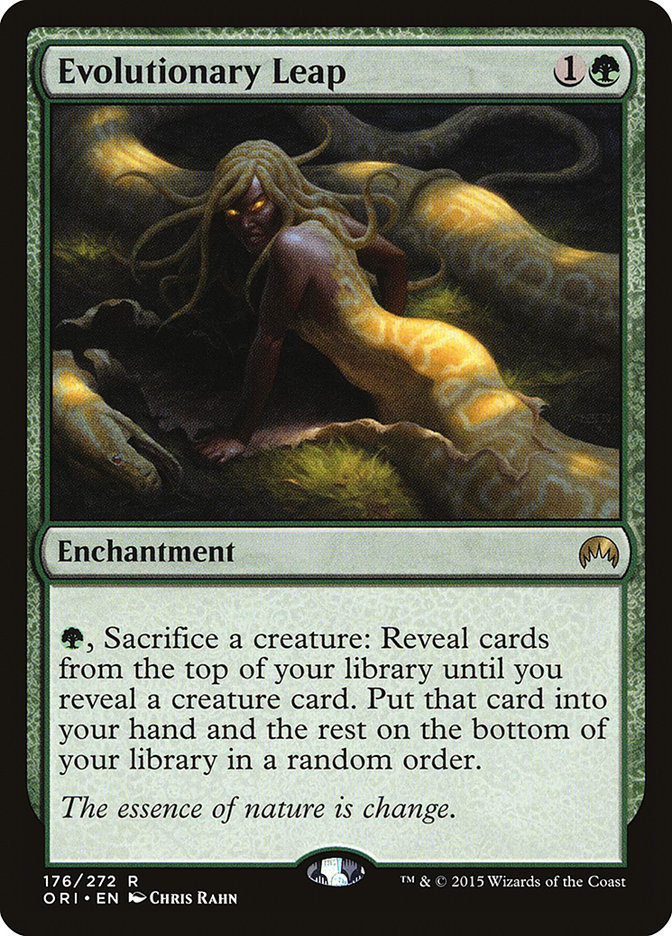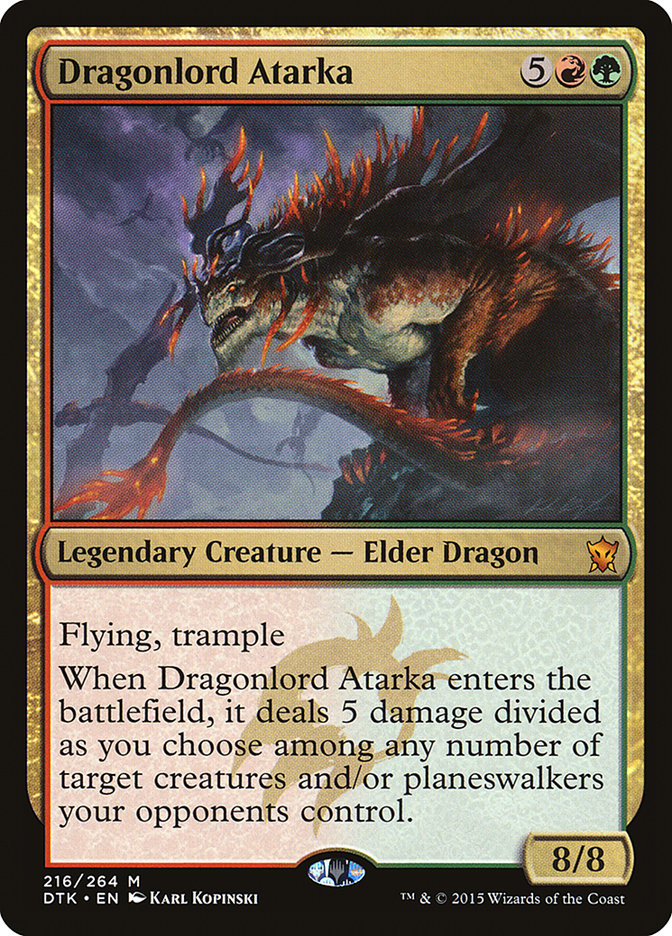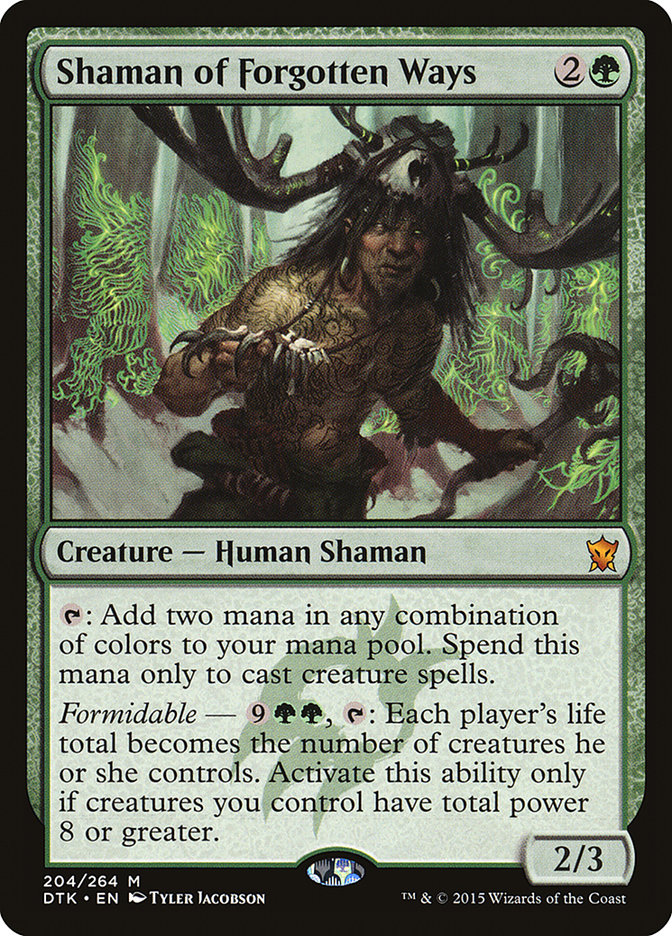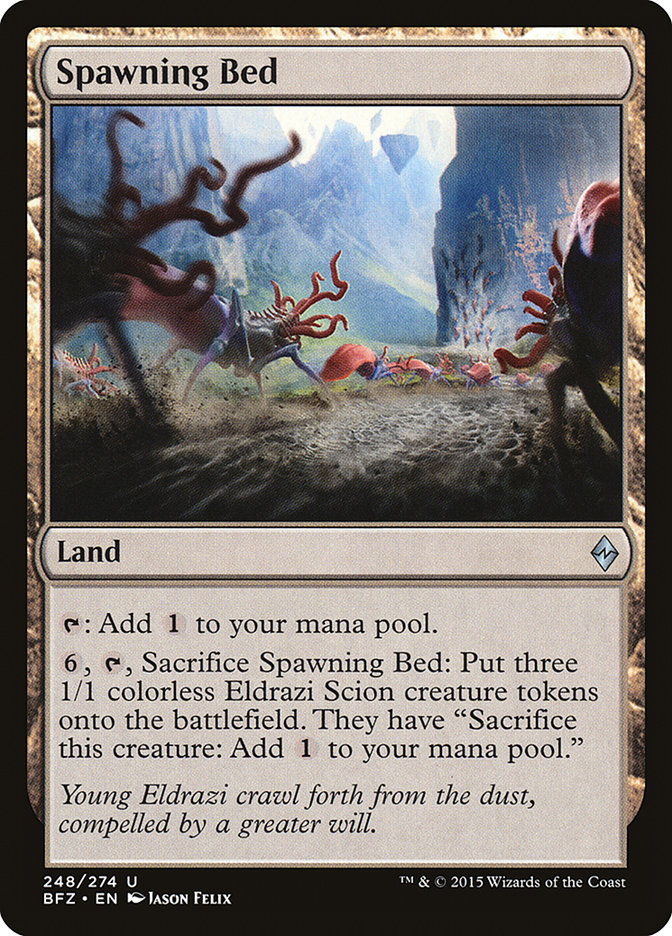Nearly half of Battle for Zendikar has been spoiled at the time of writing and one thing is clear: Wizards of the Coast wants us to play with
expensive and awesome Eldrazi creatures the same way we did during the era of Rise of the Eldrazi. While all of the pieces to the puzzle have yet
to be spoiled, we can start formulating the foundation of the Eldrazi ramp deck and start evaluating the cards available to us that come from Khans of Tarkir block and Magic Origins as well as those we’ve seen so far from Battle for Zendikar.
Let’s start with the new cards that we’re all itching to build around before moving to the existing cards to fill out the list.
The New Cards
The number one reason to play a green Eldrazi ramp deck in the first place, Ulamog, the Ceaseless Hunger is top dog of the set and looks to be stronger in
many ways to its counterpart: Ulamog, the Infinite Gyre. First off, it’s a full mana cheaper. Next it exiles two permanents on casting, rather
than destroying only one. Lastly, it doesn’t shuffle from your graveyard back into your library, allowing it to be abused by a reanimation effect or
brought back with something like Den Protector.
Of course, it’s not all upside. A single trigger of annihilator 4 would severely hamper the opponent’s resources more so than exiling the top twenty cards
does. With that said, I much prefer this new on-attack trigger to the previous one, as it puts a huge ominous clock on the opponent while still allowing
room to recover. It’s less oppressive, and while that doesn’t equate to being a better Magic card from your side, I think it’s very cool.
Not quite Primeval Titan, but even being comparable to Prime Time in the first place is a sign of a very strong card. Exiling four cards off the bat means
that you’ll nab about 1.5 lands on average, but if your opponent happened to delve any lands away or they’ve otherwise ended up exiled, perhaps through
other Eldrazi effects like Ingest, then you’re getting great bang for your buck.
The 5/8 body is both strange and huge. The problem is the number of other six-drops that seem good in the deck, like Nissa’s Renewal, Greenwarder of
Murasa, and Conduit of Ruin.
I can’t help but think of this card name belonging to a blue instant or sorcery spell rather than on a green/colorless enchantment. The obvious comparison
is to Awakening Zone, and overall I think this card is weaker. This makes 1/1s while Awakening Zone made 0/1s, and I don’t think there’s enough difference
in the two to warrant the extra mana cost. The small Eldrazi critters are either being sacrificed to make mana or chump blocking as their main function and
it’s rather foolish to think of From Beyond as a win condition akin to Bitterblossom.
As for the ability to sacrifice it for an Eldrazi… meh. I think Ulamog, the Ceaseless Hunger will be the big payoff and will be the go-to Eldrazi of
choice. It does allow you to play fewer copies of your high-end cards, and as of now, I’m willing to try it, but I’m skeptical.
The middle-man between Dreamstone Hedron and Mind Stone. Dreamstone Hedron proved to be too expensive for Constructed play, and Hedron Archive looks like
it might be too. If there’s another good early ramp spell that would enable this on turn 3, then perhaps. The one thing that Hedron Archive has going for
it that I like is that you can also cast a Hangarback Walker the turn you cast it.
Is a six-mana spell that doesn’t develop your board what you want to be doing on turn 5 or 6? I don’t think the answer is a resounding “no” and might
actually be something that we’re in the market for. Seven life is a ton, at least a turn of damage and more likely two and a three-land boost flows pretty
nicely into Ulamog, the Ceaseless Hunger. Your cards like Nissa, Vastwood Seer and Shrine of the Forsaken Gods are surely enabled, no matter how much mana
was created first from creatures like Rattleclaw Mystic. I know that the lands entering the battlefield tapped follows suit with the similar cards printed
lately, but for six mana I’d like to see an exception this time for them entering untapped, especially with how well it would be flavor-wise to cast a
Nissa, Vastwood Seer with those three untapped Forests.
Green Ramp is sorely lacking a two-drop spell or creature to go along with Rattleclaw Mystic to have the consistency it needs. Explore, Rampant Growth,
heck even Nature’s Lore or Mind Stone would all be great. However, thus far we’ve gotten this dorky Elf Shaman Ally to make mana. Looks like it’s meant for
a five-color Allies deck of sorts. The inability to make mana for things like Nissa’s Pilgrimage, From Beyond, Nissa’s Renewal, Ugin, the Spirit Dragon and
basically any plain ol’ spell restricts you to a very creature-heavy build. I do like the fact that it taps for mana the turn you play it and does a late
but passable Elvish Mystic impression at times while sneaking in to attack for one other times.
It took a while for the importance of Den Protector’s Regrowth effect to catch on as an effect worthy of the mana and time investments required of the
card. Greenwarden of Murasa is slower and much less versatile. It’s also competing with a bunch of other good six-drops and needs to actually die, not
exiled, to see the latter half of its value Regrowth. The body dies to Languish and trades in fights against Siege Rhino, but that not necessarily a bad
thing I suppose if you purely came to grind someone out.
I can’t even describe how cool this card is, yet how uncertain I am as to how it’ll perform as a top-end card. Ruinous Path and five mana sweepers will be
the most common removal spells against a huge creature like this, and they aren’t caught by the even number clause. Preventing a variety of creatures from
blocking is a cute tack-on, but what you want to be doing shortly after you cast a huge card is stabilizing, not immediately start racing. Notably though,
tokens can’t chump-block this as the card explicitly states zero is an even number and tokens have a converted mana cost of zero.
Likely better than Oblivion Sower if it stays on the battlefield. As we know, things die and it’s best to get your value upfront and not bank on being able
to cast the huge creature that you fetch up for a discount. It’s nice that they work in multiples, but by and large, I prefer Oblivion Sower for its bigger
body and (usually) guaranteed mana boost.
An Eldrazi that will always be exactly on curve with the amount of mana you have at your disposal. However, versatility isn’t what we want out of an
Eldrazi, we want raw power and the ability to recover ground that was lost while you developed the means to cast said Eldrazi. I think Endless One could be
fine in a deck that has a focus on the +1/+1 counters on your creatures with cards like Avatar of the Resolute, but as a big payoff spell, the other
options are miles better.
I like Blight Herder as a cheaper but potentially strong midgame creature that brings along an army in a can similar to powerful creatures in the past like
Siege-Gang Commander and Cloudgoat Ranger. It takes some work if your opponent isn’t helping you, and they might not even cast their delve card like
Tasigur, the Golden Fang or Treasure Cruise by the time you want to cast Blight Herder. Without the opponent’s cooperation, you have to do the work
yourself with Ingest creatures, which seems like a pretty low power-level and worth avoiding in Constructed.
An awesome card that puts a one-turn clock on the battlefield if it resolves. It’s better than Ulamog, the Ceaseless Hunger if you’re facing exactly one
removal spell (that exiles) and the opponent has no troublesome permanents on the battlefield. You also have the potential to have multiples on the
battlefield, but I don’t see that coming up ever. It looks like Desolation Twin will sit in the shadow of better ten-drop, Ulamog, the Ceaseless Hunger,
forever.
Has the same casting cost as Ugin, The Spirit Dragon which is a strike against it. Can potentially die to removal without ever impacting the board.
However, sometimes you have a bunch of mana that needs to be used for creatures and don’t quite have ten for Ulamog, so I can see this being situationally
good. Coming with a built-in Lure and obnoxiously large stats also goes a long way towards breaking through an army of blockers.
I like how this is another way to convert Hangarback Walker into Thopters. The dream is to throw Desolation Twin and his brother for the full unblockable
twenty. Barrage Tyrant’s ability would be decent as a response to removal if the cost was cheaper or if it wasn’t so fragile.
The Rollover Cards
An honorary Eldrazi, Ugin, the Spirit Dragon is one of the best end game options and the best card to ramp to in recent times. Your deck will have a
healthy number of colorless cards to dodge your own Ugin minus, and eight mana is the key number to make with seven lands, one of which is a Shrine of the
Forsaken Gods. Ugin is your means of interacting with the board in a deck that’s lacking in that function as well as being a nice win condition that ends
the game quickly.
I think Nissa, Vastwood Seer will come back in a big way now that it’s no longer competing with Courser of Kruphix for the three-mana slot that nets
land(s). The name of the game is land drops, and Nissa both guarantees one from a creature and benefits the strategy of continuing to make land drops,
whether for landfall or simply to cast your big mana spells. With a bigger focus on having lands on the battlefield in new Standard, I foresee Nissa,
Vastwood Seer to be easier to flip than ever.
This hasn’t been good in Standard thus far, but before we had better accelerants like Elvish Mystic and Sylvan Caryatid. Now I feel like a lot of the
acceleration needs to come in the form of actual lands on the battlefield, so cards like Nissa, Vastwood Seer and Shrine of the Forsaken Gods hit their
critical seven land point. I’d like to see Nissa’s Pilgrimage used alongside other useful (and hopefully cheap) instants and sorceries to backdoor the
spell mastery. It may seem like unnecessary icing on the cake, but when you’re trying to cast ten mana spells, every land is crucial.
Costs an extra mana more than Nissa’s Pilgrimage, but I wouldn’t count out playing a few copies to fill out the requisite ramping needs of the deck. Sadly,
the ability to get non-Forests to fix your color concerns likely will never come up since there are so many good colorless lands available for mono-color
decks to take advantage of.
Doesn’t directly work with the ramping theme but is one of, if not the single most powerful green card in Standard on its own. Whisperwood
Elemental gives resiliency against sweepers like Languish and Planar Outburst and makes manifests that live through the minus of Ugin, the Spirit Dragon.
There aren’t many great fives to choose from so Whisperwood Elemental ought to make any Mono-Green list, regardless of how non-thematic is it with the rest
of the cards in the deck.
Being “strictly worse” than Rattleclaw Mystic is pretty bad, even for a deck sorely wanting early acceleration. Playing a couple might be okay if times get
desperate but certainly won’t be a pleasant fate to accept.
A great way to convert Hangarback Walker into Thopters as well as a card advantage engine. Allows for playing more Nissa, Vastwood Seers as you can
sacrifice extra copies away. Burns through mana creatures after they’ve filled their roles, and you can really go off with Deathmist Raptor recursion.
The best reason to splash an additional color. Dragonlord Atarka does it all by interacting with creatures and planeswalkers and giving the deck a much
needed flyer both for blocking and as an evasive angle of attack. The clock is really fast, and a turn 4 Dragonlord Atarka is very much still a reality as
it was in G/R Devotion even without Elvish Mystic and Nykthos, Shrine to Nyx.
Once so strong that it overtook the three-drop slot from Courser of Kruphix in some G/R Devotion builds. Doesn’t cast Ugin, the Spirit Dragon, Nissa’s
sorcery ramp spells, or Evolutionary Leap, but great at casting Whisperwood Elemental, Oblivion Sower, and Dragonlord Atarka.
The Big Four
These cards are good enough to go in any green deck and have proven their power level with tournament results throughout the past three to six months.
They’re colorless or have the potential to be colorless when morphed and thus work well with Ugin, the Spirit Dragon and all of the colorless lands the
deck rightfully plays. Without further knowledge it’s a safe bet to set them as the framework for the deck given their successful track record.
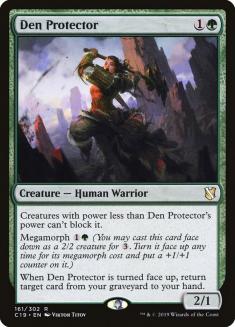
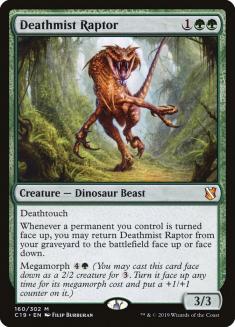
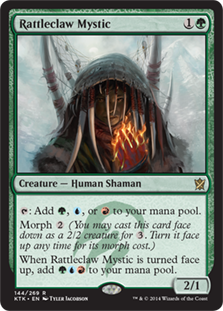
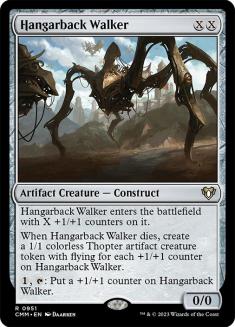

I currently favor a mono-colored deck for the Eldrazi shell as you have a lot of leniency as to the number of colorless lands you can play. And wow, are
there a bunch available to choose from. I don’t think I’ve seen this many colorless land options in such a small, five set format (or close to that number)
before. Here’s what we’ve had to choose from in Standard so far.
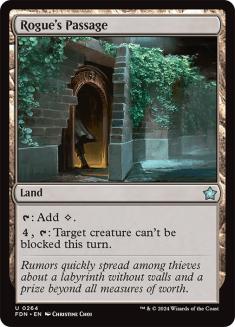
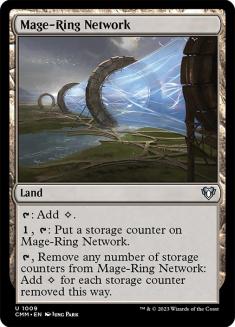
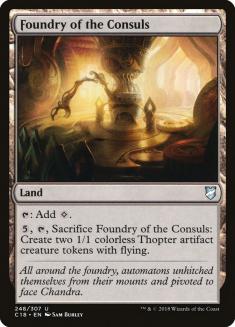
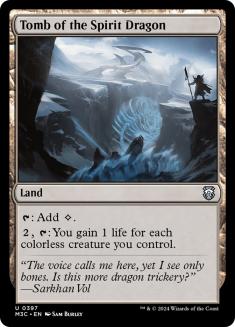
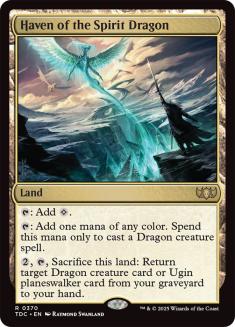

And what Battle for Zendikar brings to the table:
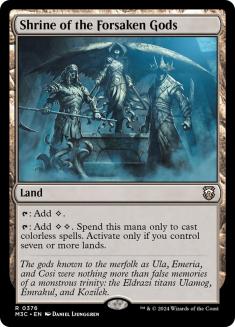
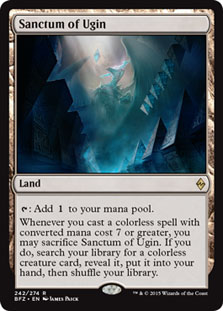

Each has their pros and cons, and we only have so much room. Over time, the cream will rise to the top and cuts will be made, but for now I like dabbling
in a few of them and seeing which are best through testing. This is the Mono-Green list I’d play in Standard once Battle for Zendikar
arrives.
I’m even going to try this one out:
Creatures (23)
- 4 Rattleclaw Mystic
- 3 Whisperwood Elemental
- 3 Den Protector
- 2 Deathmist Raptor
- 3 Nissa, Vastwood Seer
- 4 Hangarback Walker
- 2 Oblivion Sower
- 2 Ulamog, the Ceaseless Hunger
Planeswalkers (3)
Lands (26)
Spells (8)

From Beyond gets better when the 1/1s actually threaten to trade with stuff and when you go up on fetchable Eldrazi options. Tomb of the Spirit Dragon can
come in to replace something like Rogue’s Passage when you’ll be on the defensive most of the time or when you want to go up to a 27th land. Oblivion Sower
and Blight Herder are good against delve and various spot removal. Gaea’s Revenge is for the blue control decks that are likely to exist. Deathmist Raptor
and Feed the Clan are against decks trying to beatdown quickly on the ground. Void Winnower is hate against the all-even deck obviously (but also as an
option when you have more From Beyond).
And a creature-centric G/R Ramp deck…
With Cinder Glade really wanting a very low non-basic count (including themselves), I chose to go very lightly on them, with just two and a lone Rogue’s
Passage. Any double Battle land hand I’ve found to be super awkward, and I’d prefer to take an extra point of damage or so in some games from the increased
numbers of fetchlands. I don’t think there’s a huge need to cast Radiant Flames out of the sideboard for three so I’m not playing a third color of
mana, but if there is a good reason, you could get by shaving a Forest for a Canopy Vista which is fetchable by all of the lands.
At that point, you’re basically playing Naya since white mana is so accessible in this new fetchlands plus Battle land world. Cards like Dragonlord Dromka
and Hidden Dragonslayer enter the mix alongside whatever white sideboard cards you’d like. Heck, there’s probably a great Naya Dragons deck with
Thunderbreak Regent and Draconic Roar as one-of, if not the only non-creature spell in the deck that works off of the creature-mana produced from Shaman of
Forgotten Ways and Beastcaller Savant. But that’s the subject for a whole ‘nother article.
Hopefully the future spoilers improve the ramp strategy and big Eldrazis end up smacking down Siege Rhino and company to overtake the throne that’s
rightfully theirs!


